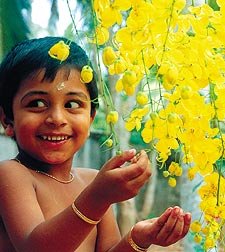On December 25th, the Sun starts its return journey to the Northern Hemisphere, a day of hope in the middle of winter and the northern hemisphere rejoices. On March 21st, the Sun crosses over into the northern hemisphere, over the equator. On this day, the sun spends equal amount of time above and below the horizon and the earth has equal daytime and nightime (though in reality the day is longer than the night). On March 21st, the centre of the Sun is directly above the equator of the Earth – more technically, the Sun is at one of two opposite points on the celestial sphere where the celestial equator and ecliptic intersect.
The Sun continues its journey northwards, and comes directly above Kerala between April 11 and April 23. Given the simplicity and aesthetic sense of the Malayali culture, we will not celebrate on all the thriteen days (overdoing things happen on the other side of the ghats, say for example Vijayakanth or Balakrishna or Rajnikanth). So Keralites celebrate “our equal day and equal night” on April 14th and call it Vishu (sanskrit for “equal”).
Kerala gets its maximum sunlight during these thirteen days, and they happen to be the hottest days in the year. Now nature never stops pampering us, and the summer rains unfailingly grace the state to quench the heat. It doesn’t stop there, the Vishu kili or Vishu pakshi (some bird) flies over the state telling farmers that its time to sow their seeds.
On the 14th, Keralites open their dreary eyes to this abundance of light and nature’s harvest. Vishu is also a celebration of the God of Light – Vishnu, who is back, and shining over us. (though malayali hindus often go by his Krishna form because we like him more). Malayalis like Mohanlal too….



vishu aashamsakal to u too 🙂
happy vishu to u too:)) adichu policho!!
Happy Vishu to you!
Happy vishu 🙂